Tessa’s Recipe Rundown
Taste: Pure chocolate heaven.
Texture: This depends on the chocolate-to-cream ratio used; it can range from rich and fudge-like to creamy and sauce-like.
Ease: Super simple.
Why You’ll Love This Recipe: An easy way to elevate any dessert!
This post may contain affiliate links. Read our disclosure policy.
Chocolate Ganache is like liquid gold! It tastes rich and decadent, has a velvety smooth texture, and looks so pretty and elegant.
Its pure chocolate flavor feels so luxurious, but it’s surprisingly simple to make!
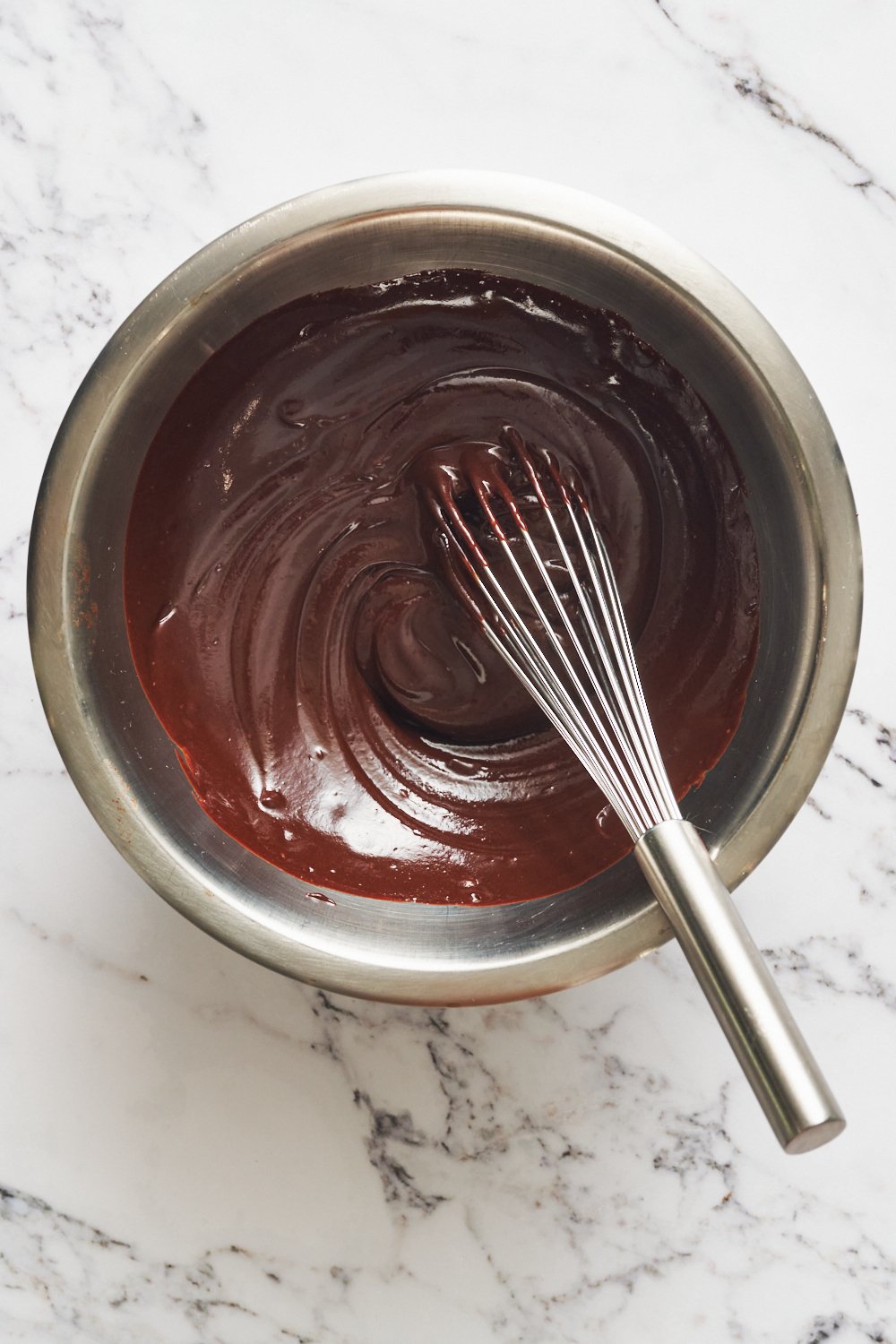
Ganache is incredibly versatile, making it a staple you’ll use again and again in your baking.

Free Ingredient Measuring Guide!
The key to consistent baking success is a click away. Sign up to get instant access to my printable Ingredient Measuring Guide now!
I love using ganache to elevate cakes like my Guinness Chocolate Cake with Irish Buttercream, in the form of heavenly Chocolate Truffles, or as a topping on my fantastic Death by Chocolate Cheesecake.
The secret to perfect ganache lies in a few simple details, so don’t miss my tips and tricks below and learn how to confidently get it right every time!

Sprinkle of Science
How to Make Chocolate Ganache
What is Ganache?
If you’ve ever sampled chocolate ganache, you may be surprised to learn that it’s a simple combination of two ingredients: chocolate and heavy whipping cream! The careful heating and combining of these two ingredients produce a rich, luscious chocolate that can be used as a cake filling, shiny frosting, decadent sauce, for making chocolate truffles, and more.
Ganache will never fully set like tempered chocolate will. It firms up as it cools and sets in the fridge, but it won’t form a crunchy crust. This means it’s the perfect topping for a special cake or beautiful cheesecake, as well as countless other uses. Enrobe ganache in tempered chocolate and you’ve got yourself a truffle!
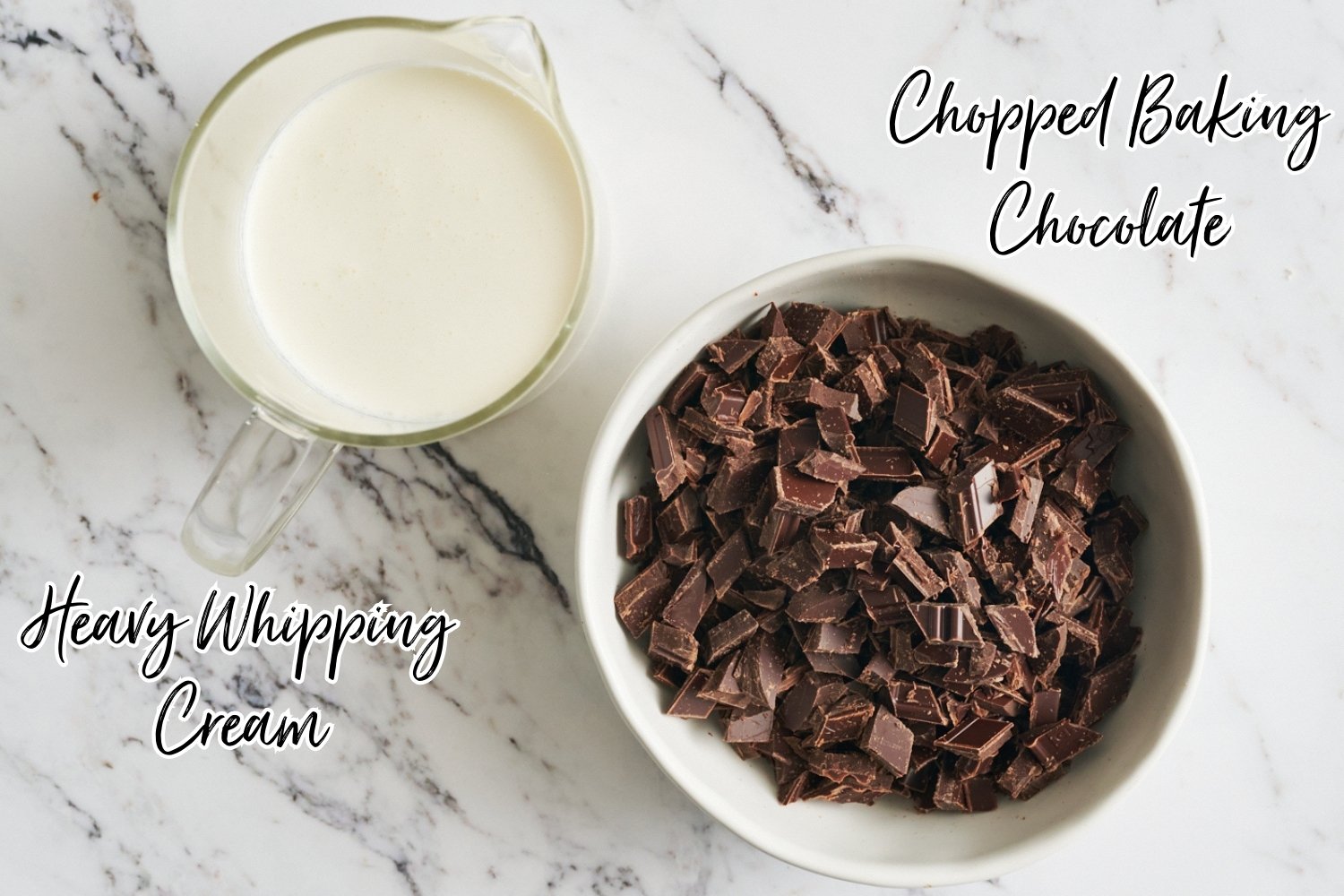
The Chocolate
Since ganache has only two ingredients, be sure to use the highest quality ingredients possible for the best flavor. I recommend using baking chocolate for ganache. Chop the chocolate with a serrated knife, being careful not to leave any large chunks.
Dark, Milk, or White Chocolate?
For the perfect balance of richness and sweetness, I recommend using semisweet chocolate in your ganache. Bittersweet chocolate is a great option if you prefer an intense chocolate flavor.
You can use milk chocolate or white chocolate, but keep in mind that unliked darker chocolate, they contain more milk, which makes it easier to scorch. Be sure not to overheat the cream when using these varieties (more on this below). The extra milk also creates a softer ganache, so I suggest reducing the amount of cream used by about a third to achieve the right consistency.
Learn more about Chocolate in Baking here.
Can I Use Chocolate Chips in Ganache?
While you technically can use chocolate chips, they won’t melt down as nicely because they contain ingredients to help them keep their chip shape. I recommend using baking bars and chopping them yourself for the smoothest texture.

The Cream
Use heavy whipping cream (also called heavy cream) for ganache. The higher the fat content of the cream, the richer and more stable your ganache will be. Do not use whipped cream (like Cool Whip), milk, or half-and-half, as they won’t allow the ganache to thicken or set correctly.
I haven’t tested any nondairy alternatives, but feel free to experiment with full-fat coconut milk or coconut cream. Keep in mind that this may result in a slightly different texture and a prominent coconut flavor.
Don’t Overheat Your Cream!
- Temperature plays a key role in making ganache.
- If your cream gets too hot, the ganache can turn grainy or separate and won’t emulsify.
- This is especially true for milk or white chocolate, but it can happen with dark chocolate too.
- Heat your cream just to a simmer before pulling it off the stove.
- If using a microwave, watch it very carefully to avoid overheating.
- Stopping at a simmer, without letting it get any hotter, will prevent your ganache from splitting.
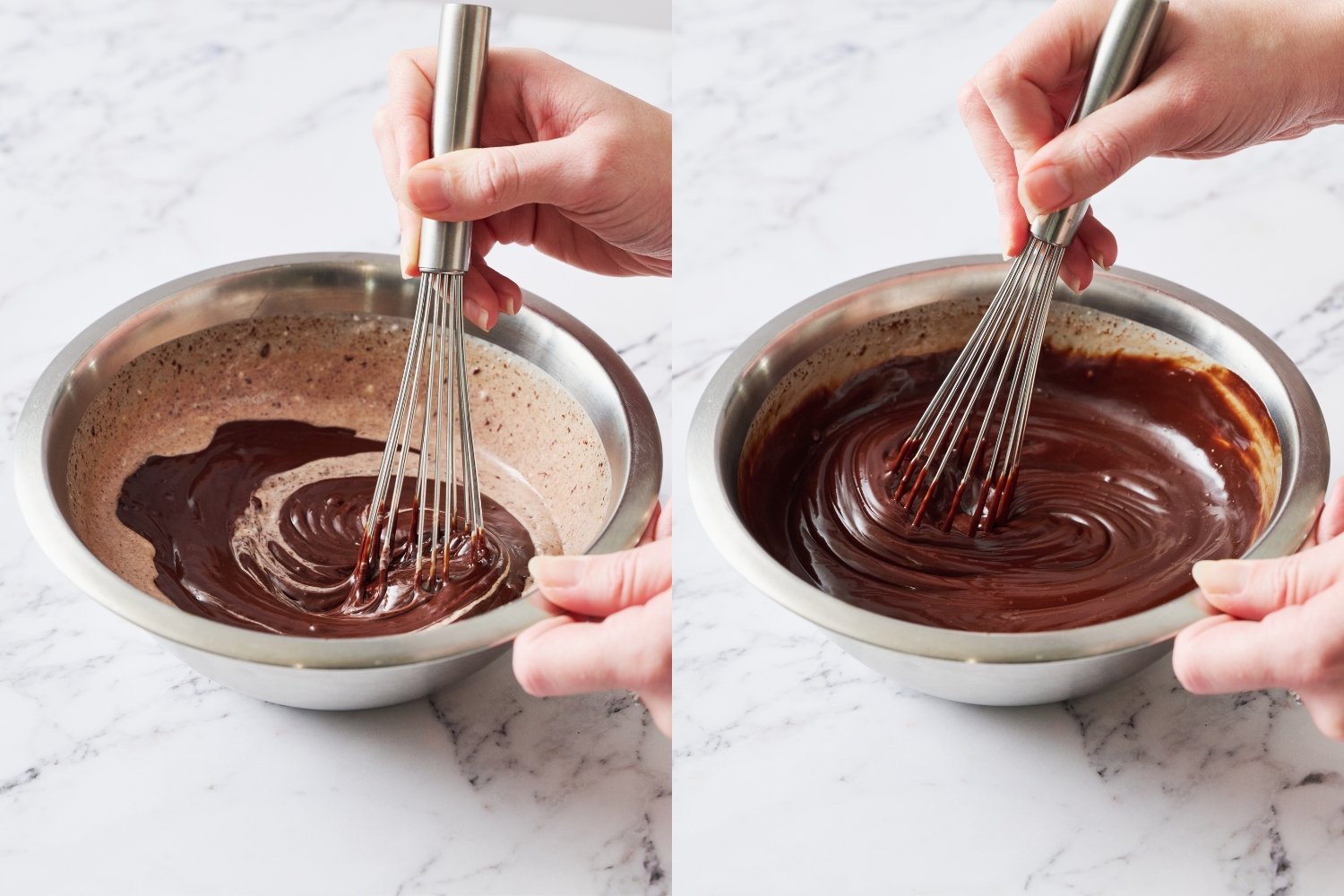
Basic Ganache Ratios
The ratio of chocolate to cream greatly impacts the final texture. The right ratio depends on your needs and preferences. Keep in mind that as ganache cools, it thickens and solidifies. Ganache with a higher chocolate ratio (such as for truffles) will set firmer, while ganache with more cream (like for glazes) will stay softer but will still firm up slightly over time.
Standard Ganache – 1:1 Ratio Ganache
Use equal parts chocolate and cream for a layer cake filling or a thick glaze, like with my Guinness Chocolate Cake with Irish Buttercream.
To glaze a cake, cheesecake, or other dessert with ganache:
- Let the ganache sit uncovered until it’s at room temperature, about 15 minutes, before pouring over the cold cake or cheesecake.
- Start pouring in the middle and gently work your way to the edges.
- If desired, let the ganache drip over the sides.
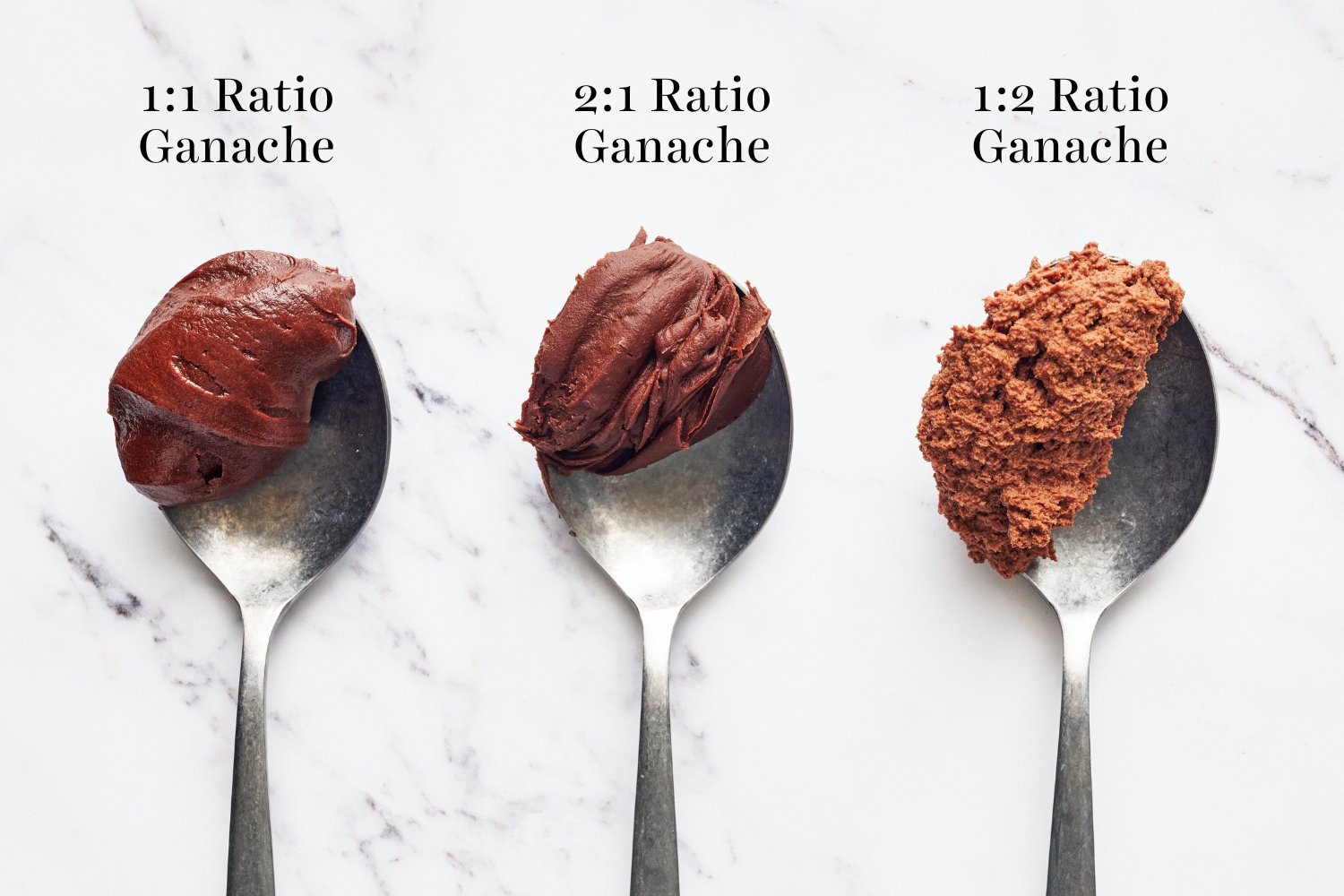
Thicker Ganache – 2:1 Ratio Ganache
For a very thick, almost fudge-like ganache, use twice as much chocolate as cream. This ratio is perfect for truffles or thick fillings for cookies, macarons, or tarts.
This ganache will solidify as it cools, especially in the fridge.
To achieve a solid yet chewy texture with a shiny finish, add 1 tablespoon of corn syrup to the cream.
For more tips on making truffles, check out my Ultimate Truffle Guide.
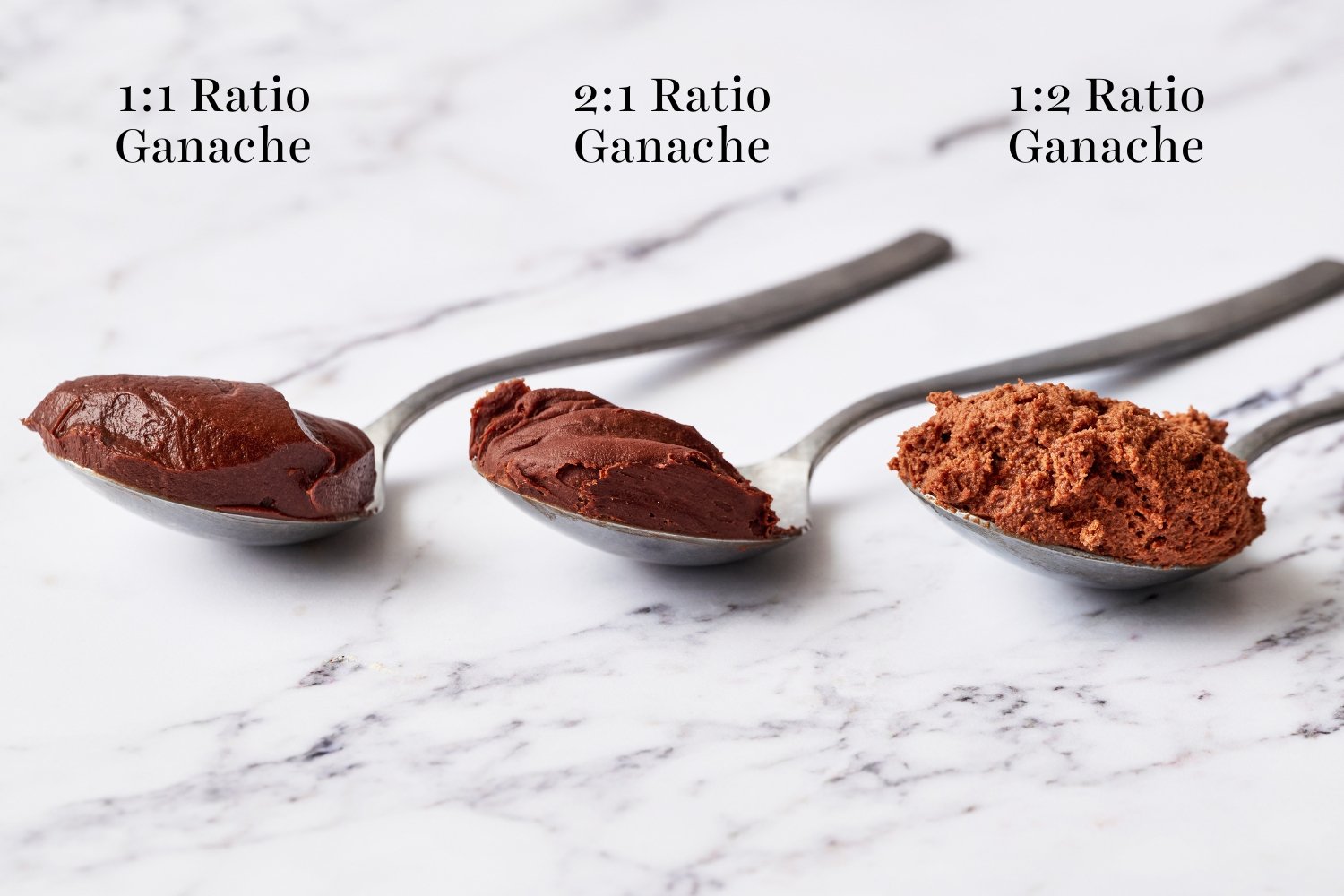
Thinner Ganache – 1:2 Ratio Ganache
For a thin, pourable ganache, use one part chocolate to two parts cream. This is perfect for dipping fruit or pouring over ice cream.
This ratio is also great for making whipped ganache (as shown in the photos), which has the taste and texture between chocolate whipped cream and mousse. It’s an incredible cake filling or cupcake frosting alternative. Allow ganache to cool completely before whipping.

Ganache Flavor Options
Some of these flavor additions may change the consistency of the ganache. Add more cream to thin or more chocolate to thicken, as needed.
- Salt: Add 1/8 teaspoon salt to the hot mixture to enhance the sweetness of the ganache.
- Liqueurs and Brandies: Swap 1-2 ounces of the cream with a flavored liqueur (e.g., Grand Marnier, Bailey’s, Chambord, etc.) or brandy (e.g., Armagnac, Cognac) to the warm ganache.
- Other Flavorings: Stir in extracts, fruit purees, espresso powder, or spices to the warm ganache.
- Peanut Butter or Nutella: Mix in 2 tablespoons to 1/4 cup of smooth peanut butter or Nutella with the chocolate and hot cream.
- Cream Infusion: Heat the cream with flavorings like fresh mint, tea, herbs (like lavender), coffee beans, or citrus zest, and let it sit for 5 to 10 minutes. Strain before using. Rewarm the cream if needed before adding to the chocolate.
Can I Halve or Double the Ganache Recipe?
Yes – simply halve or double the amounts of chocolate and cream for whichever ratio you need, keeping the ratios the same (e.g., 1:1 cream to chocolate). No other modifications needed.
How to Store Ganache
Store completely cooled chocolate ganache in an airtight container in the refrigerator for up to 1 week. Store with plastic wrap pressed against the surface to prevent any film from forming.
Cakes, cupcakes, and other baked goods filled or garnished with ganache can sit at a cool room temperature for a few hours before being covered and refrigerated.
Can You Freeze Ganache?
Completely cooled ganache can be stored inside an airtight container and frozen for up to 3 months. Allow to thaw in the fridge then let come to room temperature before using. Place in a double boiler, stirring constantly, to gently reheat if needed.

More Chocolate Recipes You’ll Love:
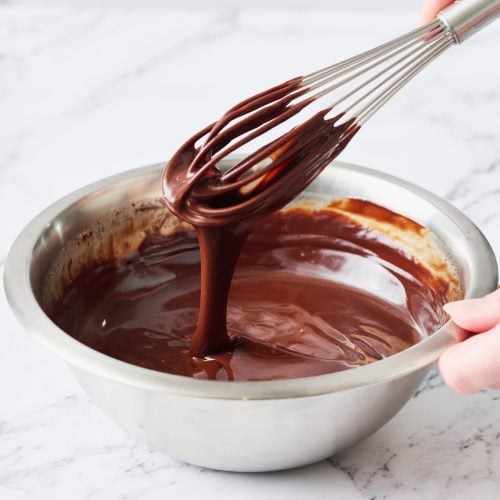
Chocolate Ganache
Email This Recipe
Enter your email, and we’ll send it to your inbox.
Ingredients
1:1 ratio ganache (for thick glazes, fillings, and frostings):
- 8 ounces (227 grams) chocolate
- 1 cup (240 grams) heavy cream
2:1 ratio ganache (for very thick, almost solid fudge-like ganache for truffles, tart fillings, etc.):
- 8 ounces (227 grams) chocolate
- 1/2 cup (120 grams) heavy cream
1:2 ratio ganache (for very thin, pourable ganache for dipping,drizzling, or whipping):
- 4 ounces (114 grams) chocolate
- 1 cup (240 grams) heavy cream
Instructions
- Coarsely chop the chocolate with a serrated knife then transfer to a heatproof bowl.
- Pour the cream into a small saucepan set over medium-high heat and bring just to a boil. Immediately remove from heat and pour over the chopped chocolate. Let stand for 5 to 10 minutes to allow the hot cream to melt the chocolate and to allow the overall temperature to reduce (emulsions form better at 90 to 110°F).
- Whisk the mixture in one direction until smooth and creamy. This may take a little while – just keep whisking until smooth, cohesive, and shiny.
- If using as a glaze, allow to cool for 15 minutes before pouring. If using for truffles, cover and chill for 1 hour, or until solid yet malleable, before scooping into balls. If using as a frosting, allow to chill for 4 hours, or until almost solidified, before using.
Whipped Ganache:
- To make whipped ganache, let a 1:2 ratio ganache chill in the fridge until thickened, about 1 hour. Whip with an electric mixer fitted with the whisk attachment, slowly increasing the speed to medium-high. Whip until light in color and fluffy in texture. Be careful not to overwhip as this can create a grainy texture. If this happens, reheat the ganache in a double boiler, then strain and start again.
Recipe Notes
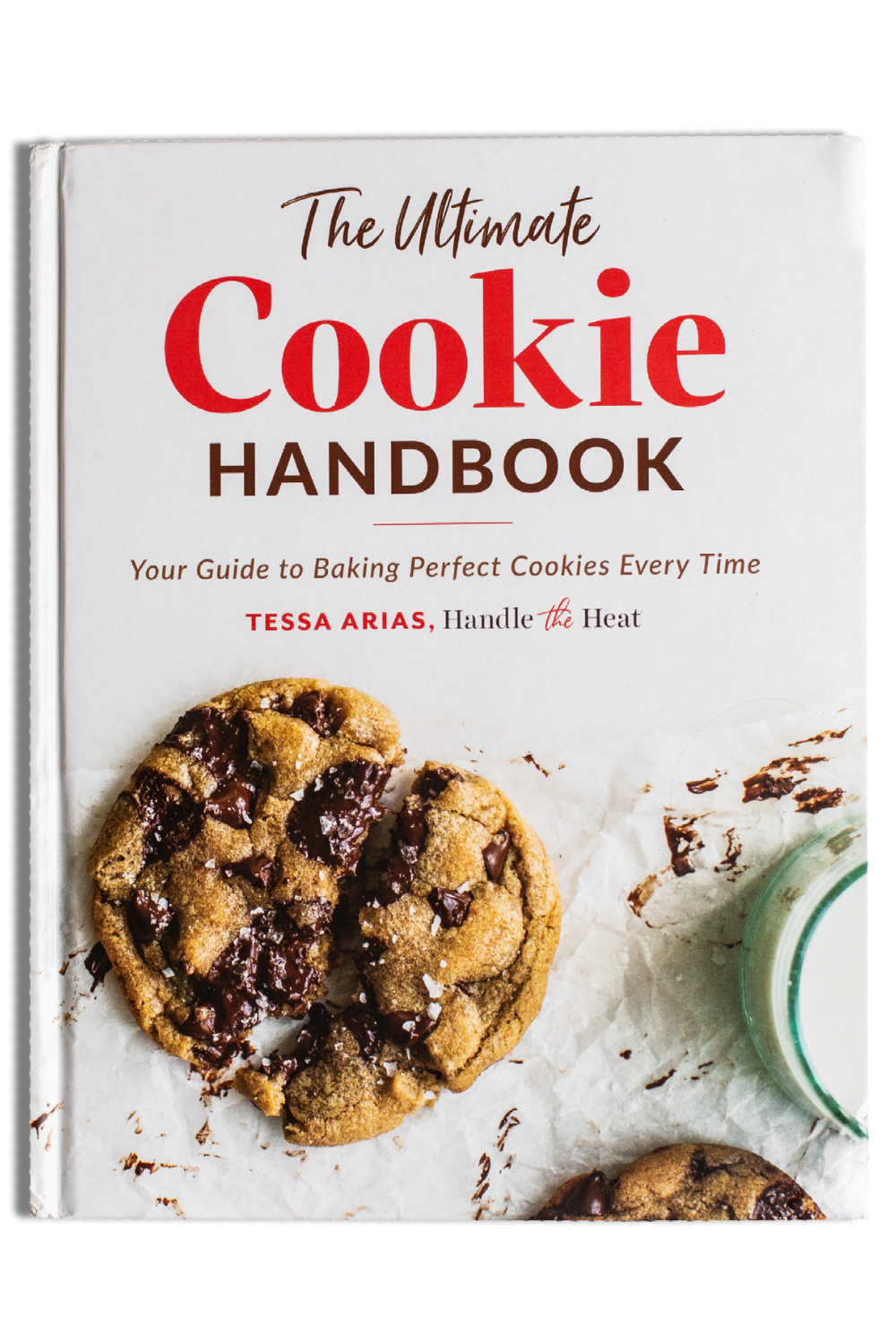
The Ultimate Cookie Handbook
Learn the sweet SCIENCE of cookie baking in a fun, visual way to customize your own recipes frustration-free. Plus, my best 50+ homemade cookies!
This post was originally published in 2015 and has been updated with additional recipe tips, Baking Science information, and new photos. Photos by Joanie Simon.

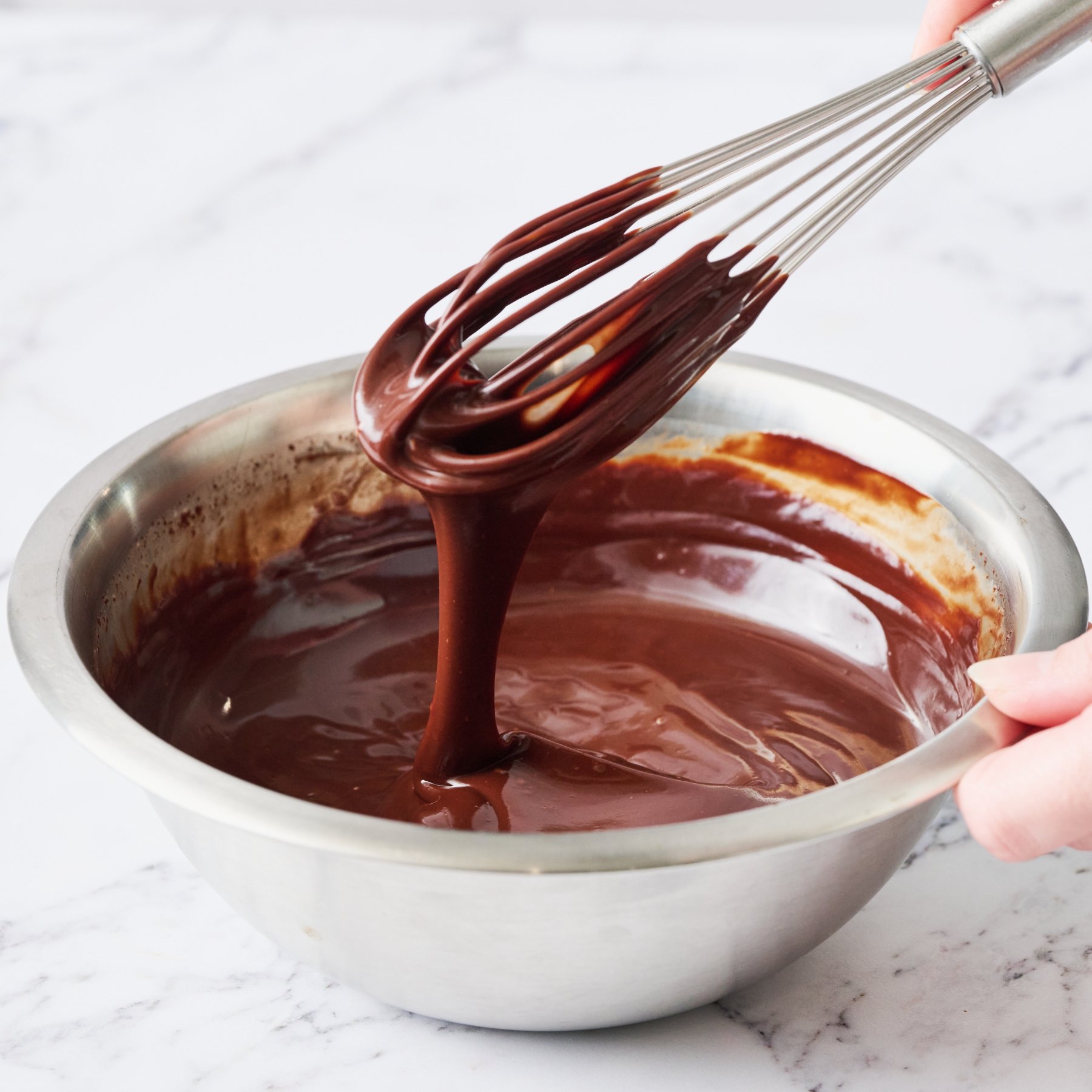

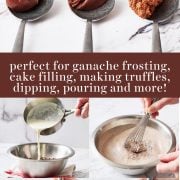
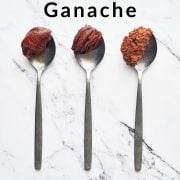

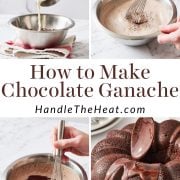
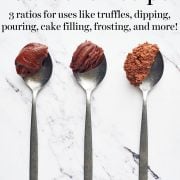
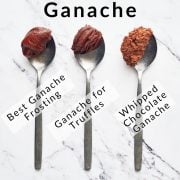

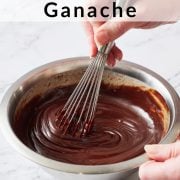
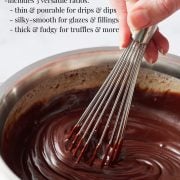

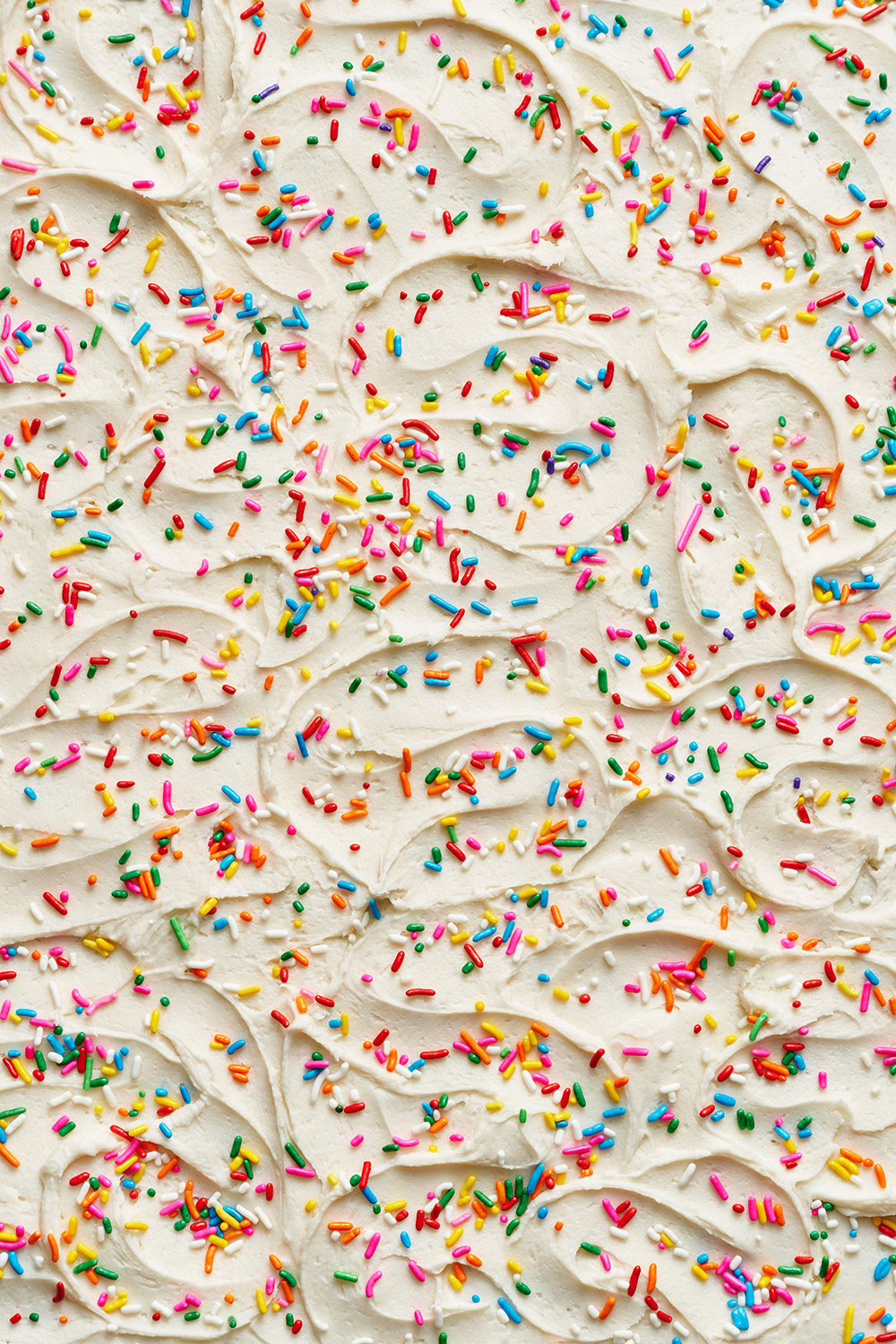
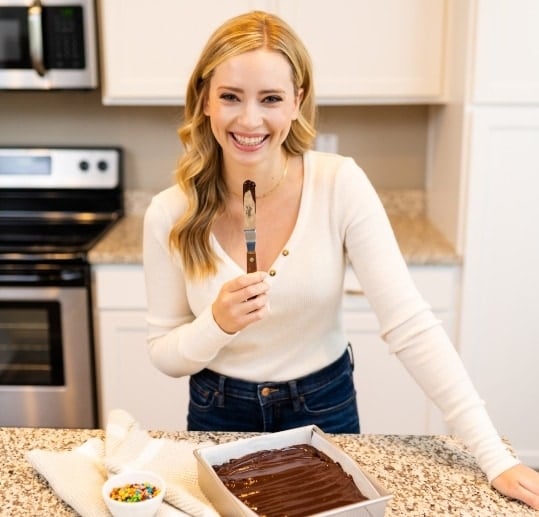


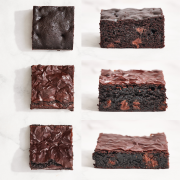
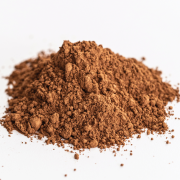
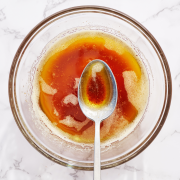

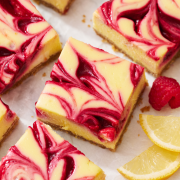
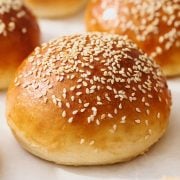









I needed some pourable ganache for donuts. This ratio was way off. I used a scale to assure that the chocolate amt was spot on. I used a bit less cream than recommended (that’s all I had on hand) and it was still way too much liquid. Luckily, I was able to pivot by melting more chocolate and heating everything at a low temp. Please rethink these measurements.
Hello, this was an amazing explanation to understand ganaches.
I will baking some cakes and will not be able to keep them refrigerated for about 7 hours. I’m looking for the ideal ganache ratio,(to be used as a frosting just over the top of a sheet cake and as a filling in another cake) that will be fluffy/soft(essentially not harden completely) but will not melt at room temperature.
I would like to know if the 2:1 ratio is ideal for this. I know buttercream would probably be a better choice but I prefer the taste of ganache.
I look forward to your response. Thank youuu !
I’ve just made 1:2 ratio of choc to thicken cream, didn’t go well. The sauce oozed out from the filling of the cake, all over my turn table and bench. It now lies in the corner near my sink, in a heap of brown muck. I weighed the choc at 200g and added 400ml of thicken cream (heated) on top stirred and then cooled before placing in my layers. What happened????
Oh no, Robyn, what a mess! I’m so sorry that happened. It actually looks like the issue was the ratio of ingredients. A 1:2 ratio creates a very thin, pourable ganache, which is great for drizzling on the top of a cake but much too loose for filling a cake. For a thick ganache that works as a filling or frosting, you’ll want to use our specific 1:1 ratio, which is 227 grams chocolate to 240 grams heavy cream. If you’re in the UK or AUS/NZ, “thickened cream” typically has a slightly lower fat content (around 35% vs. 36%+ in the U.S.), but that small difference shouldn’t cause major issues. I’d recommend adjusting to the correct ratio, and you should get the results you’re looking for. I’d love for you to give it another try, please let us know how it goes!
Hi, just a question, how long does the 1:2 ratio ganache stay as a liquid and is there any particular way to store this ganache?
Hi Nya! It completely depends on the temperature/humidity of your kitchen. The cooler your climate, the quicker the ganache will begin to thicken. Tessa actually shared details on how to store ganache above the recipe here. I recommend storing any leftovers in an airtight container in the freezer. Hope that helps!
hi, how long does the 1:1 ratio ganache keep in the refrigerator?
Hi Mai! Check out Tessa’s storage instructions in the Tip Box above the recipe, under the heading ‘Storage: How to Store Ganache’ 🙂
Question I want to use this recipe to coat a whole cake over the frosting any suggestions as to which ratios ?
Hi Ari! It depends if you’re looking to use ganache instead of a frosting / underneath fondant, or as a drip over buttercream. If you’re looking to use it instead of a frosting to coat the cake, I would recommend using the 2:1 ratio. If you wish to make a ganache drip, like in this Guinness Chocolate Cake with Irish Buttercream recipe, I would recommend the 1:1 ratio. I hope that helps! Happy baking 🙂
Hi! What is the ratio for milk chocolate and heavy cream? I don’t like the semi sweet I just made that one but I need the measurement ratio for using milk chocolate instead please and thank you!
Hi Shayla! We don’t typically use milk chocolate, so we don’t have a specific ratio/measurement to provide for you. I would recommend sticking fairly closely to the ratio Tessa provides for your desired ganache texture, and just reduce the cream slightly to prevent your ganache from being too soft. Tessa includes a couple more notes for this in the Tip Box, above the recipe. Good luck and happy baking!
Thanks for the memory refresh!!
I really appreciate your discussion of the different ratios and applications.
Dave G. ’82
hi there…i’m trying to use ganache as a filling for a sandwich cookie, but after just 5-10 minutes out of the fridge after I put it on the cookies, it started to melt and ooze out, which isn’t ideal for a stable sandwich cookie. Any tips? It was only 64 degrees in my kitchen….not that warm.
Hi Kathy! It sounds like your ganache ratio (chocolate to cream) may be off, and is returning to its semi-liquid/pourable state once out of the fridge. I recommend using Tessa’s “2:1 ratio ganache: for very thick, almost solid fudge-like ganache for truffles, tart fillings, etc.” as your filling as this should stay thick and fudgey, like the consistency of a truffle, for your filling. I hope that helps!
Hello, The recipe just says 8 oz chocolate, but it does not specify what type of chocolate. Can you provide some guidance on this? Thank you!
Hi Karen! Any good quality dark chocolate will be perfect. Semi-sweet, dark, bittersweet – any of these will be delicious, and it just comes down to how sweet you prefer your ganache. Hope that helps